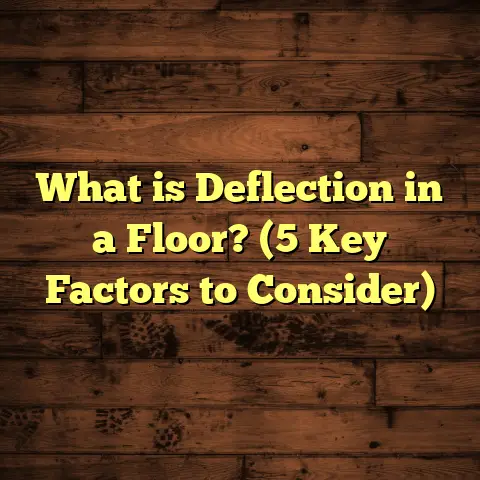What Is Slivers on Hardwood Floors? (5 Causes & Fixes Revealed)
Have you ever been walking barefoot on your hardwood floor and suddenly felt something sharp dig into your foot? That little sting is usually caused by what I call a “sliver” — a tiny, thin piece of wood that’s broken or come loose from your floorboards. It’s more than just a minor irritation. Over the years of working with hardwood floors, I’ve seen how these tiny slivers can become a real headache for homeowners.
You might be wondering: What exactly causes these slivers? Are they signs of a bigger problem? And how can you fix them without having to replace your entire floor? I’m here to walk you through everything I’ve learned—from the basics to more advanced insights. Whether you’re a DIY enthusiast or someone thinking about hiring pros, this guide will give you a clear picture of what’s going on with those pesky slivers and how to handle them.
What Is a Sliver on Hardwood Floors?
Let’s start by defining what we’re talking about here. A sliver on a hardwood floor is essentially a small fragment or splinter of wood that has broken off or loosened from the surface of your floorboards. These are usually thin, sharp, and can be barely noticeable at first or large enough to catch your skin or snag on socks.
Slivers most often occur along the edges of planks but can pop up anywhere on the surface where the wood has weakened or cracked. They are different from normal scratches or dents because they physically protrude from the floor and can cause injury if stepped on barefoot.
Why Do Slivers Matter?
Sure, they might seem minor, but these slivers are indicators of problems that could worsen if left unchecked. Here’s why I always tell my clients to pay attention:
- Injury risk: Slivers can cause painful splinters, especially for children or pets.
- Floor damage: They often mean that the wood is cracking, drying out, or suffering structural damage.
- Aesthetic impact: Visible slivers make floors look old and poorly maintained.
- Furniture and rug damage: Sharp slivers can snag or scratch furniture legs and delicate rugs.
I’ve encountered many homeowners who initially ignored slivers, thinking they were just superficial. In almost every case, the problem spread or worsened over time, leading to higher repair costs later.
What Causes These Slivers?
To fully understand slivers, we need to explore what causes them. There are several reasons why hardwood floors develop these issues. Below, I’ll share five main causes that I’ve seen repeatedly in my work, along with practical fixes.
Cause 1: Wood Quality and Natural Defects
The type and quality of wood you choose has a huge influence on how well your floor holds up over time. Not all hardwood is created equal.
What Goes Wrong?
Hardwood is a natural product with unique grain patterns, knots, and textures. Sometimes these natural features become weaknesses:
- Knots & cracks: Knots are dense areas where branches grew; they can be brittle and prone to cracking.
- Grain irregularities: Uneven grain can create tension inside boards that causes splitting.
- Improper drying: If wood isn’t dried properly during manufacturing (kiln-drying), it retains excess moisture leading to warping and splitting later.
In my early years as a flooring contractor, I recall a project where subpar oak planks were used due to budget constraints. Within the first winter’s dry indoor heat, numerous slivers appeared as the wood contracted unevenly. We ended up replacing many boards—a costly lesson on why quality wood matters.
How to Spot Low-Quality Wood?
- Boards with visible cracks or large knots.
- Boards that feel overly soft or brittle.
- Wood that smells musty (indicating improper drying).
- Inconsistent color or grain patterns.
Fixes for Slivers From Poor Wood Quality
- Replacement: In most cases where defective wood causes slivers, replacing affected planks is the best long-term solution.
- Sanding & Refinishing: For minor slivers or surface cracks, sanding the floor smooth followed by refinishing can reduce further damage.
- Sealants: Applying high-quality sealants helps protect wood from moisture changes that worsen splitting.
Data Point
According to industry standards, properly kiln-dried hardwood should have a moisture content between 6% and 9%. Wood above this range is at higher risk for warping and cracking after installation.
Cause 2: Environmental Conditions—Humidity & Temperature Changes
Wood floors breathe—they expand and contract depending on moisture levels in the air. This movement is natural but can cause problems if not managed.
Why Do Humidity Changes Cause Slivers?
When humidity drops too low (common in winter with indoor heating), wood dries out and shrinks. This shrinking creates gaps between boards and stress along edges where slivers may form.
Conversely, high humidity causes wood to absorb moisture and swell. When it then dries unevenly, cracks and splinters can develop.
I worked in a home near the coast where humidity swings were extreme. The owner ignored using any humidity control devices. After a few years, several floorboards developed slivers due to repeated cycles of swelling and shrinking.
How to Maintain Proper Conditions
- Keep indoor humidity between 35% and 55% year-round.
- Use humidifiers in winter when air is dry.
- Use dehumidifiers in damp environments or rainy seasons.
- Maintain consistent indoor temperature between 60°F and 80°F.
- Keep windows closed during harsh weather changes when possible.
Preventive Measures
- Choose engineered hardwood in moisture-prone areas because it’s more stable than solid wood.
- Install proper vapor barriers under floors in basements or ground-level rooms.
- Promptly clean up water spills to prevent moisture damage.
Case Study
A National Wood Flooring Association survey found homes with controlled indoor humidity reported 45% fewer flooring issues like cracking and slivers over two years compared to uncontrolled environments.
Cause 3: Installation Errors
Even the best wood can fail if installed incorrectly. The installation process plays a huge role in whether your floor will develop slivers or not.
Common Installation Mistakes That Lead to Slivers
- Skipping acclimation: Wood planks must be brought into the home and left to adjust to indoor climate for 3+ days before installation.
- Wrong fasteners: Using inappropriate nails or adhesives can cause boards to loosen over time.
- Poor board spacing: Overly tight boards don’t allow for natural expansion causing edge lifting and splintering.
- Uneven subfloor: An uneven base stresses boards causing cracks and slivers.
When I was starting out as an installer, I remember working on a job where the crew skipped acclimation due to schedule pressure. The result? Boards started shrinking within weeks causing multiple slivers along joints. We had to redo large sections after proper acclimation was done.
How To Avoid Installation Issues
- Always acclimate hardwood planks at least 72 hours before installation.
- Use manufacturer-approved nails or glue.
- Maintain recommended expansion gaps around room edges.
- Level subfloor before installation.
- Hire experienced installers if you’re not confident doing it yourself.
Industry Insight
Reports show installation errors account for nearly 30% of early hardwood floor failures, including issues like splintering and slivering.
Cause 4: Regular Wear and Tear
Even perfectly installed floors suffer wear from everyday life—foot traffic, pets’ claws, moving furniture—all contribute over time.
How Does Wear Cause Slivers?
Small chips or dents accumulate from dropped objects or abrasion. If left untreated, these minor surface damages can deepen into cracks and loose splinters.
I once helped a homeowner whose floors had many small dents from heavy furniture legs dragged across over years without protection. These small damages eventually turned into slivers requiring sanding across large areas.
How To Protect Floors from Wear
- Use rugs or runners in high traffic areas.
- Attach felt pads under furniture legs.
- Avoid dragging heavy furniture; lift instead.
- Clean floors regularly with pH-neutral products to avoid damaging finishes.
- Refinish floors every 7–10 years depending on traffic levels.
Maintenance Tip
Regular inspections allow you to catch chip damage early before they become dangerous splinters.
Cause 5: Pest Damage—Termites & Wood Borers
Although less common in treated modern hardwoods, insect damage can cause internal weakening leading to surface slivers.
How Do Pests Cause Slivers?
Termites or wood-boring beetles tunnel inside wood planks eating away structural fibers without immediately visible damage on surface. Over time this hollowing weakens wood causing pieces to break off as slivers.
One client called me after noticing sharp slivers near windowsills. A pest inspection revealed termite activity beneath floorboards. After treatment and board replacement, the slivering stopped.
How To Prevent Pest Damage
- Have regular pest inspections especially in humid areas.
- Use treated wood resistant to termites when building or renovating.
- Keep crawl spaces dry to discourage pest infestation.
- Immediately replace damaged boards after pest remediation.
How To Repair Slivers on Hardwood Floors: A Practical Guide
If you’re dealing with slivers right now, here’s a step-by-step method I recommend for repairs that don’t require full replacement:
Tools You’ll Need:
- Fine grit sandpaper (120–220 grit)
- Wood glue
- Wood filler/putty matching floor color
- Putty knife
- Vacuum or tack cloth
- Matching wood finish/sealant
- Utility knife or small chisel
Step 1: Clean the Area
Vacuum around the sliver removing dirt and dust so repair materials adhere better.
Step 2: Trim Loose Splinters
Use utility knife to carefully cut off any sharp protrusions without damaging surrounding wood.
Step 3: Apply Wood Glue (If Sliver Still Attached)
Put glue under loose pieces then clamp gently until dry (usually 24 hours).
Step 4: Fill Gaps with Wood Filler
Use putty knife to fill holes or cracks left by removed slivers with colored wood putty matching your floor tone.
Step 5: Sand Smooth
Once filler dries fully, sand lightly until flush with rest of floor surface using fine grit sandpaper.
Step 6: Apply Finish/Sealant
Apply matching finish (polyurethane or oil-based) over repaired area restoring protection and shine.
Long-Term Care Tips To Avoid Future Slivers
Based on my years fixing floors, here are some habits that help keep floors splinter-free:
- Maintain stable indoor humidity levels.
- Clean spills immediately.
- Avoid harsh chemicals or abrasive cleaning tools.
- Use protective pads on chairs/furniture.
- Refinish floors periodically before wear becomes visible.
- Schedule professional inspections every few years especially in older homes.
Unique Case Studies From My Experience
Case Study 1: Coastal Home Moisture Damage
A family living near the ocean had engineered hardwood installed but neglected humidity control. After two years, multiple boards developed slivers due to fluctuating moisture levels. After installing dehumidifiers and replacing damaged sections with more moisture-resistant flooring, issues stopped completely within six months.
Case Study 2: Termite Infestation Under Hardwood
In an older rural home, unexplained splinters near doorways led me to recommend pest inspection. Termites were confirmed damaging subfloor and plank edges internally. Treatment plus full plank replacement resolved the issue permanently.
Some Statistics Worth Considering
| Issue | Percentage of Hardwood Floor Problems | Source |
|---|---|---|
| Installation-related defects | ~30% | NWFA Industry Reports |
| Moisture-related damage | ~35% | NWFA Survey |
| Wear & tear issues | ~25% | Flooring Contractor Data |
| Pest-related damage | ~5% | Pest Control Industry Studies |
These numbers underscore how multiple factors contribute but many are preventable with proper care and installation.
Final Thoughts From Me
Slivers might look like small annoyances but they say a lot about your hardwood floor’s health. Catching causes early—whether it’s poor wood quality, environmental shifts, installation mistakes, wear, or pests—can save you lots of time and money later.
If you’re unsure about what’s causing your floor’s problems or want professional advice on repairs, don’t hesitate to reach out to flooring experts who can provide thorough inspections.
And if budgeting is a concern for repair versus replacement options, tools like FloorTally can give you accurate local cost estimates tailored to your project needs — something I use regularly myself!
What about you? Have you ever dealt with irritating floor splinters? How did you fix them? Feel free to share your story; sometimes hearing real experiences helps others decide their next step!





